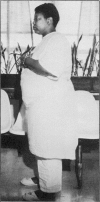Abstract
It is the primary purpose of this treatise to outline the essential differences between empty sella syndrome (ESS) and pseudotumor cerebri (PTC). An attempt is made to determine why these syndromes may coexist. A detailed case report is presented which emphasizes the definitive signs and symptoms that are found in patients having both of these syndromes, and differentiation is made between idiopathic and secondary ESS.
Full text
PDF




Images in this article
Selected References
These references are in PubMed. This may not be the complete list of references from this article.
- BUSCH W. Die Morphologie der Sella turcica und ihre Beziehungen zur Hypophyse. Virchows Arch Pathol Anat Physiol Klin Med. 1951 Sep;320(5):437–458. doi: 10.1007/BF00957474. [DOI] [PubMed] [Google Scholar]
- Bergland R. M., Ray B. S., Torack R. M. Anatomical variations in the pituitary gland and adjacent structures in 225 human autopsy cases. J Neurosurg. 1968 Feb;28(2):93–99. doi: 10.3171/jns.1968.28.2.0093. [DOI] [PubMed] [Google Scholar]
- Foley K. M., Posner J. B. Does pseudotumor cerebri cause the empty sella syndrome? Neurology. 1975 Jun;25(6):565–569. doi: 10.1212/wnl.25.6.565. [DOI] [PubMed] [Google Scholar]
- Lipton H. L., Michelson P. E. Pseudotumor cerebri syndrome without papilledema. JAMA. 1972 Jun 19;220(12):1591–1592. [PubMed] [Google Scholar]
- Venable H. P. Pseudo-tumor cerebri. J Natl Med Assoc. 1970 Nov;62(6):435–440. [PMC free article] [PubMed] [Google Scholar]
- Venable H. P. Pseudo-tumor cerebri: further studies. J Natl Med Assoc. 1973 May;65(3):194–197. [PMC free article] [PubMed] [Google Scholar]








